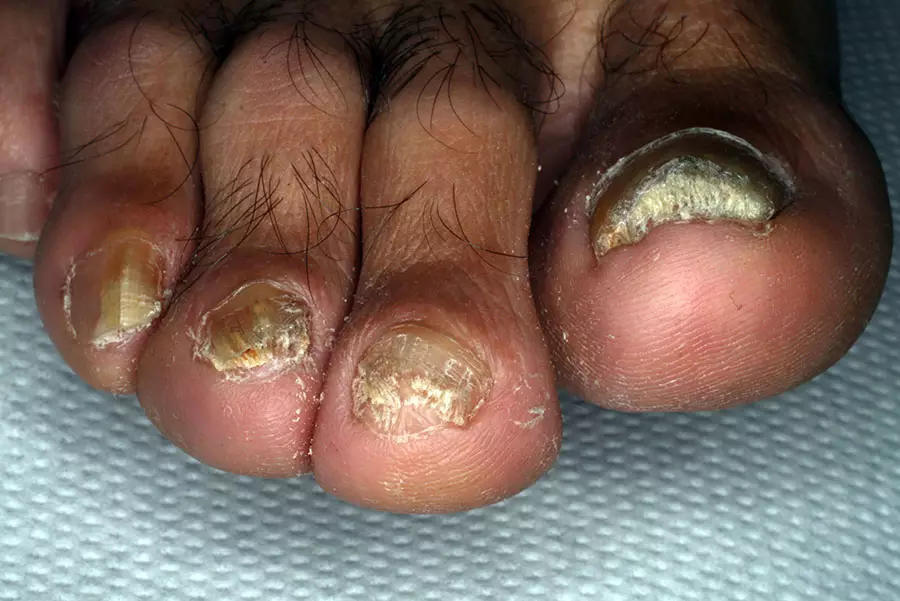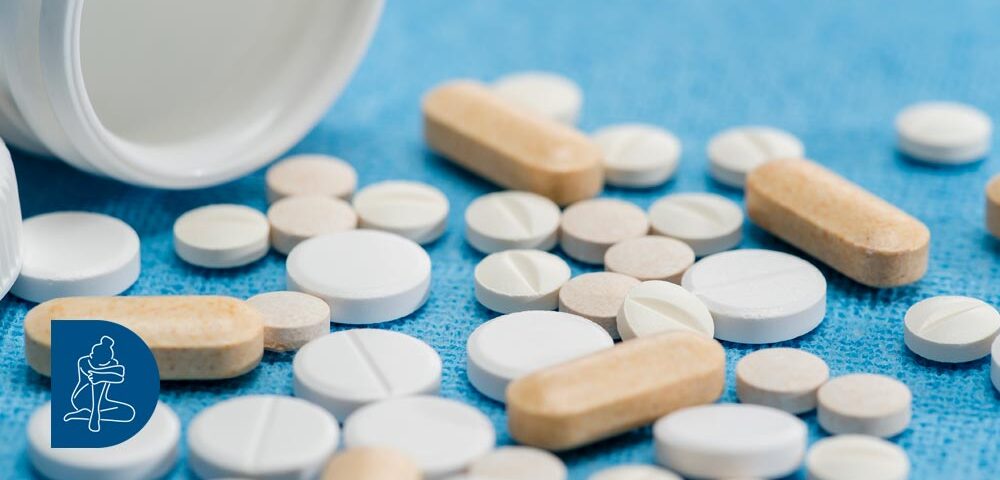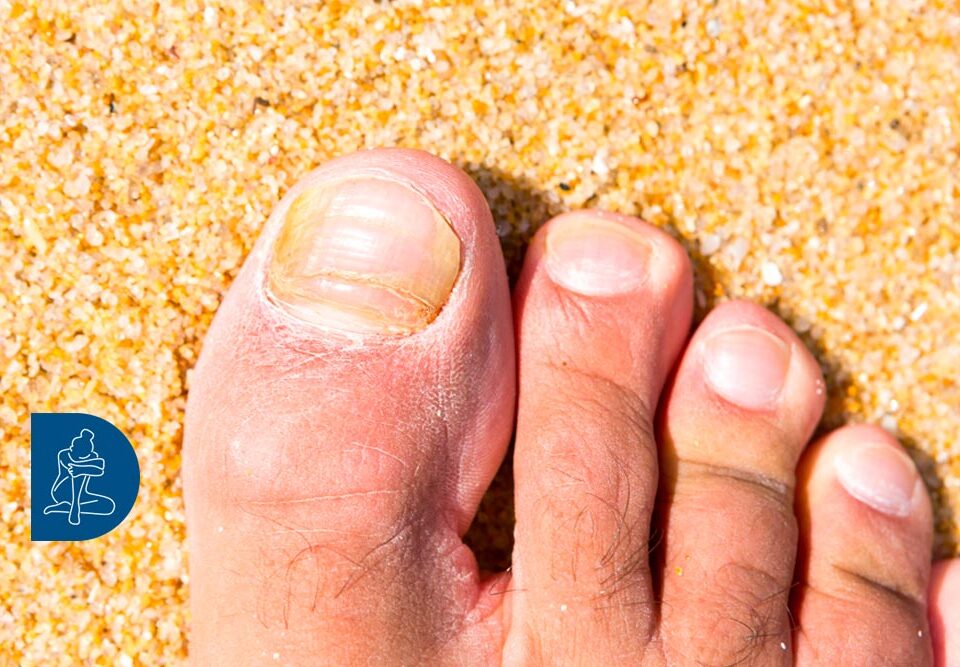
Toenails and Mycosis: Treatment and Prevention Strategies
21/09/2023
Athlete’s foot: recognising and treating it correctly
21/09/2023
Athlete’s foot can affect the skin and nails, both of which can be treated with antifungal systemic and local pharmaceuticals or non-pharmaceuticals.
Antifungal pharmaceuticals break down the fungus’ cell wall which protects it from the external environment.
Drugs belonging to the terbinafine group block the fungus’ transition from the squalene to the squalene epoxide, while drugs in the azoles group block the transition from lanosterol to ergosterol.
In order to work, these drugs have to wait for the fungus to reduplicate and for the fungal cell walls to form, meaning that they can be classified as fungistatic pharmaceuticals.
Azoles are synthetic compounds that are classified as either imidazoles or triazoles.
Imidazoles include pharmaceuticals like ketoconazole, miconazole and clotrimazole.
Triazoles include drugs such as itraconazole, fluconazole, voriconazole, and posaconazole.
Terbinafine is a synthetic allylamine that inhibits the enzyme’s squalene epoxidase.
This causes the accumulation of excess squalene that is toxic to the microorganism.
Another drug active against dermatophytes but with a different mechanism of action from the previous ones is Griseofulvin.
Griseofulvin is an insoluble fungistatic drug derived from a species of penicillium that tackles dermatophytes in a slightly different way.
While its exact mechanisms aren’t well known, griseofulvin appears in the newly formed stratum corneum by binding to keratins to stop the proliferation of dermatophytes.
For the treatment of onychomycosis or athlete’s foot, oral pharmaceuticals are often prescribed, as local administration (e.g. creams) often cannot properly penetrate the nail plate.

Treatment of onychomycosis with systemic antifungals
The drugs that can be used are:
ITRACONAZOLE
- Drug specialties: sporanox, triasporin, generic itraconazole
- Dosage: 200 mg twice a day for seven days for one week a month for three months
- Side effects: nausea, abdominal pain, liver dysfunction
FLUCONAZOLE
- Medicinal specialties: diflucan, elazor, generic fluconazole
- Dosage: 400 mg one day a week for six to nine months
- Side effects: vomiting, abdominal pain, diarrhea,skin rash, headache, altered liver
TERBINAFINE
- Medicinal specialty: Daskil, Lamisil, generic Terbinafine
- Dosage: one 250 mg dose per day for three or more months
- Side effects: gastrointestinal disturbances, allergic reactions
Considerations when treating onychomycosis with antifungals
- The drugs have general side effects that must be considered in relation to the particular length of treatment.
- Gastrointestinal, allergic, and hepatic side effects are sometimes so severe that treatment often cannot be completed.
- Results are uncertain and recurrences frequent.
Treatment of onychomycosis with filmogen-borne drugs
TROSYD NAIL SOLUTION
-
- 12ml bottle
- Thioconazole 28 %
- Excipients: undecylenate; ethyl acetate
Treatment duration lasts, on average, up to six months, but can be extended for up to one year.
Trosyd should be applied to the infected nail and periungual region using a suitable brush in the morning and evening.
The solvent dries in five minutes, leaving a thin, transparent and oily film.
LOCETAR NAIL POLISH
- 2.5ml bottle
- Amorolfine hydrochloride 5 %
- Excipients: methacrylic acid copolymer; triacetin; butyl acetate; ethyl acetate; absolute ethyl alcohol
Apply once or twice a week to fingernails or toenails.
For toenails, treatment lasts for between nine to twelve months.
BATRAFEN NAIL POLISH
- Bottle 3g
- Ciclopirox 8%
- Excipients: methoxyethene; polymer with 2-butenedioic acid; monobutyl ester; ethyl acetate; isopropyl alcohol
Apply a thin layer once per day to the affected nail.
The duration of treatment depends on the severity of the infection, but should not exceed six months.
Considerations when treating onychomycosis with filmogen-carried drugs
Treatment is effective only on rarer, supra-laminar infections and does not impact intralaminar or sublaminar infections is doubtful.
For filmogen drug treatment to be successful, consistency is a must and application must be accurate.
Treatment with filmogen is also expensive and may cause localized allergic reactions.
Final considerations on the use of antifungal drugs for the treatment of onychomycosis
Given the toxicity and cost of nail fungus treatments, it’s important to consider, among other factors, whether the treatment is suitable before starting, based on the following points:
- a healthy nail plate is unlikely to become infected;
- a pathological nail plate (psoriasis, dystrophy, etc.) remains pathological even after antifungal treatment and is at risk of reinfection;
- a pathological nail plate is often colonized by commensal fungi that are not the cause of the nail pathology and do not require treatment.
Topical antifungal drugs to treat athlete’s foot
Medications to treat athlete’s foot are usually creams containing antifungals in varying concentrations that act topically on the affected area:
CLOTRIMAZOLE
Medicinal substance: canesten BIFONAZOLE
Medicinal substances: azolmen, bifonazol ECONAZOLE
Medicinal substances: ifenec, pevaryl FENTICONAZOLE
Medicinal substances: flavin, lomexin, lorenil NAFTIFINE
Medicinal substance: suadian TERBINAFINE
Medicinal substances: daskin, lamisil TOLNAFTATE
Medicinal substance: tinaderm
AMOROLFINE
Medicinal substance: locetar CYCLOPIROX
Medicinal substance: batrafen
Considerations when treating athlete’s foot with topical antifungal drugs
Treating athlete’s foot topically with antifungal drugs has several drawbacks.
In general, antifungal drugs do not have a particular affinity for the skin which means that, in order for antifungals to work, they must be repeatedly applied twice per day over a relatively long period.
Having to apply the topical product twice a day results in macerative effects, especially if applied between the interdigital spaces.
Finally, topical medications do not help in the prevention of fungi in individuals at risk of infection or reinfection.

Non-pharmaceuticals to treat athlete’s foot and onychomycosis
Many non-pharmaceutical agents possess considerable antifungal properties:
- Plant extracts: tea tree oil; salicylic acid
- Mineral derivatives: sulfur; selenium; copper
- Sedimentary derivatives: ichthyol sulfonate; ammonium sulphoxylate
- Dyes: fuchsin; eosin
- Antiseptic chemicals: resorcinol; phenol
However, many of the above cannot be used for a variety of reasons including toxicity by absorption, skin sensitization, photosensitization and skin staining etc.
Criteria for non-pharmaceutical treatments
- No toxicity
- No allergenicity
- Efficacy
- Skin tolerance
- Acceptability
As in traditional dermatology, the agents used as antifungals are sulfur and salicylic acid.
Sulfur
Sulfur has many biological effects:
- At a low concentration, it is keratoplastic. This means that it binds to cysteine forming cystine, which are amino acids that the stratum corneum is rich in. The formula is: 2 cysteine + cystine sulfur + H2S (hydrogen sulfide)
- At a high concentration, sulfur is a keratolytic that breaks down keratins through hydrogen sulfide (H2S)
Antifungal effect of sulfur:
- Using skin bacteria and through interaction with keratinocytes, sulfur produces pentatonic acid (H2S5O6), which is toxic to dermatophytes, as well as some yeasts and molds.
To be active on the skin, sulfur must be in colloidal form because:
- colloidal sulfur has particles that are between 100 to 1000 times smaller than precipitated sulfur;
- it disperses uniformly on the skin and,
- it can be used at lower concentrations to fulfill the same activities as other treatments
Salicylic acid
Chemically, salicylic acid is a beta hydroxy acid and, like sulfur, has many different properties:
- it is antimicrobial on both bacteria and fungi,
- at a concentration of 2%, it boosts desquamation
- at concentrations of above 5%, it is a keratolytic
- when used together with sulfur, salicylic acid enhances antimicrobial and desquamation actions through synergism
DermaClub recommends 2S Cream, a sulfur salicylic acid cream that can be used to treat several skin conditions of the feet:
- acts as a reducing agent for various forms of psoriasis, including plantar dyshidrosis and psoriatic onychopathy;
- has antifungal properties in treating athlete’s foot, plantar mycosis and dorsal mycosis;
- when combined with nail filing, it is an antifungal in the treatment of nail mycoses
Advantages of using 2S Cream:
- Affinity with the stratum corneum
Sulfur and salicylic acid bind to the stratum corneum stably which allows them to continue working long after application, to the point of practically eliminating the fungus through desquamation.
- Reduced frequency of application
The cream’s components have a high affinity for the stratum corneum, meaning that only one application per day is needed to achieve the desired curative activity. This increases the compliance of those undergoing treatment.
- Accelerated remission of mycosis
Due to lengthy retention in the stratum corneum, the cream’s active components are constantly working, thus speeding up treatment time.
- No maceration
The absence of vaseline in 2S Cream prevents maceration from occurring.
- High tolerance
With active ingredients at low concentrations of just 2%, 2S Cream is well tolerated by the skin even over prolonged treatments.
- Preventative
Given its long-lasting antifungal properties, 2S Cream is recommended in preventive treatments for those at risk of infection (e.g. athletes, immunocompromised, diabetics).
- Keratolytic and antifungal
Unlike antifungal creams, 2S Cream is a keratolytic which facilitates the detachment of scales and fungi that stagnate under the lamina and in the lateral valleys.
- One application per day
Treatments for onychomycosis are often numerous and lengthy, but 2S Cream requires just one application per day which helps the patient adhere to and be consistent with application.
- Can be combined with nail filing
Filing the nail plate helps both to eliminate surface lamellae parasitized by mycetes and to facilitate the penetration of 2S Cream into the deeper layers of the lamina. Filing and 2S Cream therefore complement each other.
- Works on the psoriatic component together with nail filing
Often on a psoriatic nail with sloughing (onychosis) and detachment from the nail bed, mycetes such as molds or yeasts can breed easily. In such cases, the reducing and antifungal actions of 2S Cream, alongside filing, make it possible to treat psoriasis and nail mycosis simultaneously.




